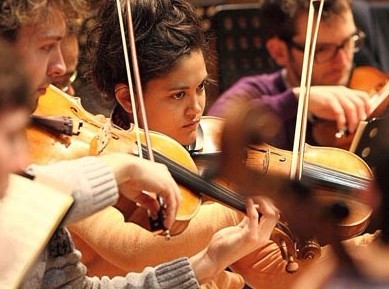Books and Arts; Music Review;
The Aldeburgh World Orchestra
Beach music
120 players from 35 countries have a ball

The musicians who got off the bus all wore the same black hoodies with “Aldeburgh World Orchestra 2012” printed on the back. But the cases they carried were far from uniform. There were pocket-sized boxes for the piccolos, a wheeled-trolley for the harp and knobbly trunks, all barnacled in stickers, for the cellos. The English seaside town of Aldeburgh, the home of Benjamin Britten, is used to welcoming performers from all over the world, but nothing on this scale; a musical Olympiad of 120 players from 35 countries.
Through its Britten-Pears young artist programme, Aldeburgh Music has earned a world-class reputation as a centre for the development of musical talent. When the programme's 40th anniversary coincided with London's Olympic games, Aldeburgh Music's chief executive, Jonathan Reekie, decided the moment had come for Aldeburgh to take a leap ahead and create a “world” orchestra. Most orchestras—even the most international ensembles—recruit largely from Europe and America. The challenge for Mr Reekie and his team in creating the Aldeburgh World Orchestra (AWO) was to seek out 18-29-year-olds and use modern technology to try to make the orchestra truly global.
The £700,000m project, which has received public and corporate funding, began three years ago with a call for YouTube submissions. Then Marie Bennell, the AWO's orchestra manager, travelled to Mexico to watch a rehearsal of the Youth Orchestra of the Americas, an important recruiter of regional talent. Patricia da Silva, a Brazilian double-bass player who is no more than five feet tall, stood out for her steady hand and warm personality. The British Council in Egypt called the Cairo Conservatoire, who suggested Marcellino Safwat, a 17-year-old cellist with ambitions to become a conductor. A colleague in Tokyo sent word to China, where YouTube is banned, and old-fashioned demo tapes began to pour in. Over eight weeks Ms Bennell watched and listened to more than 600 submissions.
She was determined to put together an ensemble that was capable of taking on a demanding repertoire and producing a unified sound. For that, she needed not just technical ability, but a steeliness of character and a willingness to listen. Players emerged in clusters, often grouped around an outstanding teacher. South Africa produces excellent string players, many of them taught by 82-year-old Jack de Wet (who taught Ms Bennell), and Sophie Cherrier has made France the country to go to for young flautists. Britain dominates the orchestra's brass section, inspired by Richard Watkins, the Philharmonia's former principal hornplayer, who is now a professor at the Royal Academy of Music. The final selection was truly international: the cello section alone has players from ten countries, including Palestine and South Africa.
In Sir Mark Elder, the AWO found exactly the conductor it needed. Fiercely demanding and articulate, he is also “incredibly kind”, Ms Bennell says. He is music director of the Hallé orchestra in Manchester, where he teaches conducting; he has also worked with Britain's National Youth Orchestra, and knows from experience that creating an ensemble of young players is an emotional and psychological process that requires a willingness to concentrate and cannot easily be hurried.
Some of the less experienced musicians were taught, before they arrived, by professional musicians in Britain whose instructions were relayed by videoconference. Once in Aldeburgh, each section worked for a week with a specialist before the full rehearsals. A number of them played alongside their pupils in front of the conductor, which, for some, was itself an experience to remember. As Ms da Silva posted on Facebook: “The unthinkable happened today: I played with the principal bassist of the Berlin Philharmonic. I still can't believe it!”
It was important, Sir Mark says, “to set the musical bar very high—and then ensure that they get up there.” Setting a high bar meant choosing a demanding repertoire: the strange and ambiguous Fifth Symphony that Dmitri Shostakovich wrote in 1937 when he had fallen out of grace with Stalin and the Communist Party, but was determined to go on composing in Russia, and the Sinfonia da Requiem, with its brilliant brass fanfares and heavy funeral march, that Britten wrote in 1940 as Europe was engulfed in war.
These musical responses to the worst that the 20th century could throw at the world had a resonance for many of the players, especially those from troubled parts of Russia, Central Asia and the Middle East. Rehearsing the first movement of the Shostakovich, Sir Mark was determined that the players should plumb the musical depths. “It has to be more powerfully played, more brilliantly played,” he insisted. “It has to feel like a crisis; all the ideas in the music are threatening to explode. It must never feel like café music.” Aldeburgh may be a small seaside town, but there has been nothing small about creating this world orchestra.
The Aldeburgh World Orchestra will be performing at the Snape Maltings concert hall near Aldeburgh on July 20th and 22nd, at the Ingolstadt festival in Germany on July 25th, the Concertgebouw in Amsterdam on July 27th and at the BBC Proms at London's Royal Albert Hall on July 29th.












